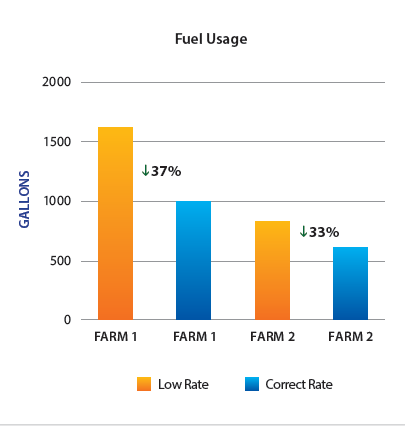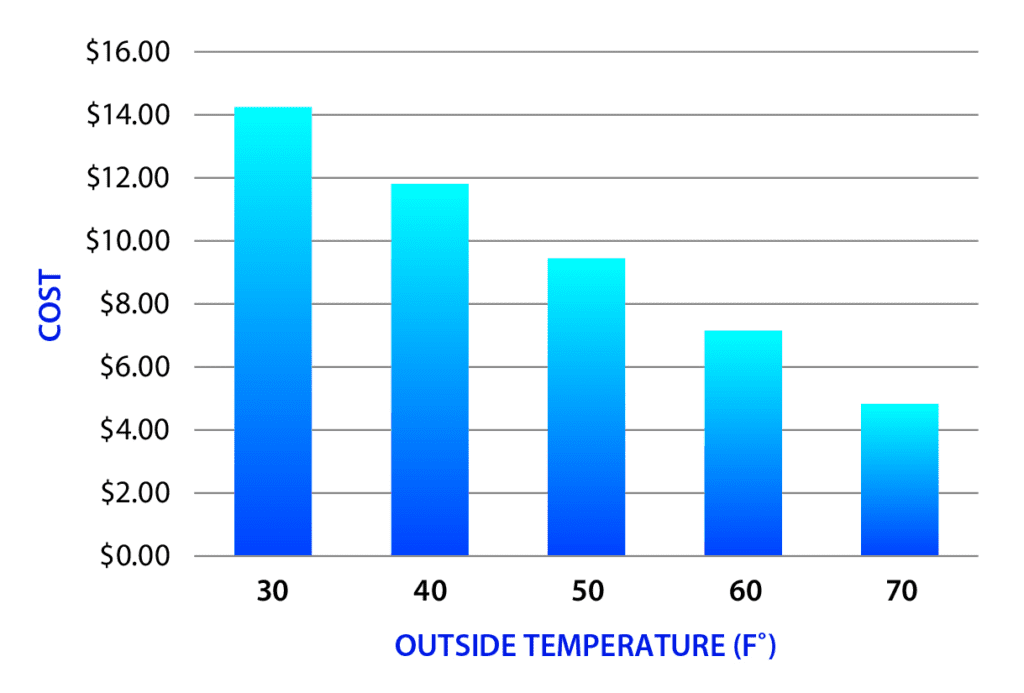Increasing your PLT application rate to control more ammonia can actually help increase your net profit by lowering winter fuel costs.
WHERE’S THE PROOF?
A study completed in both North (Farm 1) and South (Farm 2) U.S. climates compared PLT application rates that were either too low or sufficient for litter conditions*.

THE CORRECT OR SUFFICIENT RATE OF PLT DECREASED FUEL USAGE

POTENTIAL FUEL SAVINGS
At the current fuel price of roughly $2 a gallon, that would equate to
600 gallons of propone on the northern farms = Savings of $1,200 per flock
300 gallons of propone on the southern farms = Savings of $600 per flock
HOW DO I KNOW WHAT RATE IS SUFFICIENT FOR MY LITTER?
100 lbs./1,000 sq. ft.
- Litter age < 1 year
- Varied particle size, 4-5 inches deep
100-150 lbs./1,000 sq. ft.
- Decaked litter older than 1 year
- Deep litter ammonia reading between 150-300 PPM
- Litter depth below 6 inches
150-200 lbs./1,000 sq. ft.
- Tilled/windrowed litter 2+ years
- Deep litter ammonia readings 300+ PPM
- Deep, fine litter
- Little downtime
HOUSE AND LITTER MANAGEMENT TIPS TO CUT BACK MORE ON FUEL COSTS
Instead of cutting back on heating to lower fuel costs, increase your PLT application rate and try focusing on these tips to maximize the value of your heat bill.

Use PLT at the correct rate for your litter condition. Lower fuel costs in winter by applying PLT at a rate sufficient for your litter conditions in order to control ammonia.

Close houses up tight right after catch to preserve heat. In cold weather, this practice keeps the floor 20-30˚F warmer than it would be if the houses were left open – greatly decreasing the amount of fuel necessary for pre-heat. Plus, utilizing litter heat from the previous flock helps reduce the amount of ammonia that needs to be managed at the beginning of the next flock.

Pre-heat an empty house. The most efficient time to use fuel is while the house is empty. As litter temperature rises, there will be a purge of ammonia. Pre-heating before PLT is applied and chicks arrive is critical to extend the life of PLT and maximize air quality for chicks.

Don’t focus on air temperature lost by ventilating purged ammonia. Floor temperature will not be lost and the air temperature will quickly return once the brooders are turned back on. Failing to purge out the released ammonia will result in a loss of 4-5 days in longevity of PLT which will cost far more in terms of fuel and bird performance. Even at $2/gallon in 30˚F temperatures, replacing the heat from purging ammonia only costs $14 (per UGA calculator).


Lower overall fuel usage with proper pre-heating steps. By removing ammonia and achieving floor and core litter temperatures before birds arrive, ventilation demands post-placement are reduced and floor temperature is maintained rather than lost through excess ventilation.

Insufficient pre-heat can decrease performance. Running a short pre-heat time in a misguided effort to save fuel will not warm the house and litter properly. Birds will feel the impact of cool temperatures, raising mortality and decreasing performance. Numerous researchers have reported that birds placed on floors even as little as five degrees cooler than optimal temperature gain significantly less weight than when placed on warm floors.
